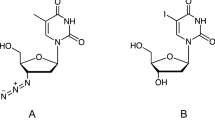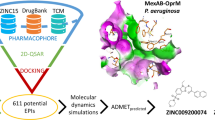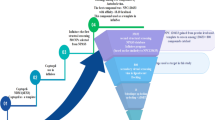Abstract
Pseudomonas aeruginosa (P. aeruginosa) is an opportunistic bacterium that frequently causes nosocomial infections. New generation cephalosporins and β-lactams along with inhibitors are used for the treatment of opportunistic bacterial infections. The indiscriminate use of antibiotics has led to the emergence of bacterial resistance. Carbapenem class of antibiotics like imipenem and meropenem are currently the final line of antibiotics for the treatment of infections caused by multidrug-resistant P. aeruginosa. Recent reports indicate that P. aeruginosa has acquired resistance to imipenem through a class D oxacillinase—OXA-10 extended spectrum β-lactamase (ESBL). OXA-10 ESBL is encoded by the gene blaOXA-10. There is an urgent need to develop OXA-10 ESBL non-hydrolysing inhibitors. We have attempted to locate OXA-10 ESBL inhibitors by performing molecular docking and molecular dynamics studies on OXA-10 ESBL with imipenem analogues from ZINC database as well as employing imipenem to understand the mechanism of resistance at the structural level. Our in-silico analysis of imipenem analogues reveals that ZINC44672480 has ideal characteristics for a potent OXA-10 ESBL non-hydrolysing inhibitor. We believe that the results from our study will provide valuable insights into the mechanism of drug resistance and aid in designing potent inhibitors against OXA-10 ESBL producing P. aeruginosa.








Similar content being viewed by others
Abbreviations
- ESBL:
-
Extended spectrum β-lactamase
- OXA:
-
Oxacillinase
- PDB:
-
Protein data bank
- C-score:
-
Consensus score
- MD:
-
Molecular dynamics
- PASS:
-
Prediction of activity spectra for substances
- RMSD:
-
Root mean square deviation
- RMSF:
-
Root mean square fluctuation
- Rg:
-
Radius of gyration
References
Lister, P. D., Wolter, D. J., & Hanson, N. D. (2009). Antibacterial-resistant Pseudomonas aeruginosa: clinical impact and complex regulation of chromosomally encoded resistance mechanisms. Clinical Microbiology Reviews, 22, 582–610.
Kang, C. I., Kim, S. H., Kim, H. B., Park, S. W., Choe, Y. J., Oh, M. D., et al. (2003). Pseudomonas aeruginosa bacteremia: risk factors for mortality and influence of delayed receipt of effective antimicrobial therapy on clinical outcome. Clinical Infectious Diseases, 37, 745–751.
Beck, J., Vercheval, L., Bebrone, C., Herteg-Fernea, A., Lassaux, P., & Marchand-Brynaert, J. (2009). Discovery of novel lipophilic inhibitors of OXA-10 enzyme (class D beta-lactamase) by screening amino analogs and homologs of citrate and isocitrate. Bioorganic & Medicinal Chemistry Letters, 19, 3593–3597.
Walther-Rasmussen, J., & Hoiby, N. (2006). OXA-type carbapenemases. Journal of Antimicrobial Chemotherapy, 57, 373–383.
Lavanya, P., Ramaiah, S., Singh, H., Bahadur, R., & Anbarasu, A. (2015). Investigations on the role of CH…O interactions and its impact on stability and specificity of penicillin binding proteins. Computers in Biology and Medicine, 65, 85–92.
Lavanya, P., Bag, S., Ramaiah, S., & Anbarasu, A. (2015). Importance of cation-π interactions in the conformational stability and specificity of β-lactamases. Journal of Indian Chemical Society, 92, 1008–1010.
Lavanya, P., Ramaiah, S., & Anbarasu, A. (2014). Binding site residues in β-lactamases: Role in non-classical interactions and metal binding. Journal of Coordination Chemistry, 67, 2898–2910.
Lavanya, P., Ramaiah, S., & Anbarasu, A. (2014). Computational analysis of N-H…π interactions and its impact on the structural stability of β-lactamases. Computers in Biology and Medicine, 46, 22–28.
Massova, I., & Mobashery, S. (1998). Kinship and diversification of bacterial penicillin-binding proteins and β-lactamases. Antimicrobial Agents and Chemotherapy, 42, 1–17.
Weldhagen, G. F., Poirel, L., & Nordmann, P. (2003). Ambler class A extended-spectrum β-lactamases in Pseudomonas aeruginosa: novel developments and clinical impact. Antimicrobial Agents and Chemotherapy, 47, 2385–2392.
Luyt, C. E., Aubry, A., Lu, Q., Micaelo, M., Brechot, N., Brossier, F., et al. (2014). Imipenem, meropenem, or doripenem to treat patients with Pseudomonas aeruginosa ventilator-associated pneumonia. Antimicrobial Agents and Chemotherapy, 58, 1372–1380.
Taccone, F. S., Cotton, F., Roisin, S., Vincent, J. L., & Jacobs, F. (2012). Optimal meropenem concentrations to treat multidrug-resistant Pseudomonas aeruginosa septic shock. Antimicrobial Agents and Chemotherapy, 56, 2129–2131.
Farshadzadeh, Z., Khosravi, A. D., Alavi, S. M., Parhizgari, N., & Hoveizavi, H. (2014). Spread of extended-spectrum β-lactamase genes of blaOXA-10, blaPER-1 and blaCTX-M in Pseudomonas aeruginosa strains isolated from burn patients. Burns, 40, 1575–1580.
Zafer, M. M., Al-Agamy, M. H., El-Mahallawy, H. A., Amin, M. A., & El Din Ashour, S. (2015). Dissemination of VIM-2 producing Pseudomonas aeruginosa ST233 at tertiary care hospitals in Egypt. BMC Infectious Diseases, 15, 122.
Jones, R. N. (2001). Resistance patterns among nosocomial pathogens: Trends over the past few years. Chest, 119, 397S–404S.
Parimelzaghan, A., Anbarasu, A., & Ramaiah, S. (2016). Gene Network Analysis of metallo beta lactamase family proteins indicates the role of gene partners in antibiotic resistance and reveals important drug targets. Journal of Cellular Biochemistry, 117, 1330–1339.
Lavanya, P., Ramaiah, S., & Anbarasu, A. (2016). A molecular docking and dynamics study to screen potent anti-staphylococcal compounds against ceftaroline resistant MRSA. Journal of Cellular Biochemistry, 117, 542–548.
Anitha, P., Anbarasu, A., & Ramaiah, S. (2016). Gene network analysis reveals the association of important functional partners involved in antibiotic resistance: A report on an important pathogenic bacterium Staphylococcus aureus. Gene, 575, 253–263.
Danel, F., Paetzel, M., Strynadka, N. C., & Page, M. G. (2001). Effect of divalent metal cations on the dimerization of OXA-10 and -14 class D β-lactamases from Pseudomonas aeruginosa. Biochemistry, 40, 9412–9420.
Bush, K., & Jacoby, G. A. (2010). Updated functional classification of beta-lactamases. Antimicrobial Agents and Chemotherapy, 54, 969–976.
Naas, T., & Nordmann, P. (1999). OXA-type beta-lactamases. Current Pharmaceutical Design, 5, 865–879.
Bush, K., Jacoby, G. A., & Medeiros, A. A. (1995). A functional classification scheme for β-lactamases and its correlation with molecular structure. Antimicrobial Agents and Chemotherapy, 39, 1211–1233.
Nordmann, P., & Guibert, M. (1998). Extended-spectrum beta-lactamases in Pseudomonas aeruginosa. Journal of Antimicrobial Chemotherapy, 42, 128–131.
Mugnier, P., Casin, I., Bouthors, A. T., & Collatz, E. (1998). Novel OXA-10-derived extended-spectrum β-lactamases selected in vivo or in vitro. Antimicrobial Agents and Chemotherapy, 42, 3113–3116.
Nass, T., & Nordmann, P. (1999). OXA-type beta-lactamases. Current Pharmaceutical Design, 5, 865–879.
Danel, F., Hall, L. M., Gur, D., & Livermore, D. M. (1998). OXA-16, a further extended spectrum variant of OXA-10 β-lactamase, from two Pseudomonas aeruginosa isolates. Antimicrobial Agents and Chemotherapy, 42, 3117–3122.
Paetzel, M., Danel, F., de Castro, L., Mosimann, S. C., Page, M. G., & Strynadka, N. C. (2000). Crystal structure of the class D beta-lactamase OXA-10. Nature Structural & Molecular Biology, 7, 918–925.
Vahaboglu, H., Ozturk, R., Akbal, H., Saribas, S., Tansel, O., & Coskunkan, F. (1998). Practical approach for detection and identification of OXA-10-derived ceftazidime-hydrolyzing extended-spectrum β-lactamases. Journal of Clinical Microbiology, 36, 827–829.
Kumar, K. M., Lavanya, P., Anbarasu, A., & Ramaiah, S. (2014). Molecular dynamics and molecular docking studies on E166A point mutant, R274N/R276N double mutant, and E166A/R274N/R276N triple mutant forms of class A β-lactamases. Journal of Biomolecular Structure & Dynamics, 32, 1953–1968.
Anitha, P., Lavanya, P., Anbarasu, A., & Ramaiah, S. (2014). Molecular docking study of Catechins compounds from Camellia sinensis against UPPS in Staphylococcus aureus. International Journal for Computational Biology, 3, 3–9.
Kumar, K. M., Anitha, P., Sivasakthi, V., Bag, S., Lavanya, P., Anbarasu, A., et al. (2014). In-silico study on Penicillin derivatives and Cephalosporins for Upper Respiratory Tract bacterial pathogens. 3Biotech, 4, 241–251.
Anitha, P., Anbarasu, A., & Ramaiah, S. (2014). Computational gene network study on antibiotic resistance genes of Acinetobacter baumannii. Computers in Biology and Medicine, 48, 17–27.
Kumar, K. M., Anbarasu, A., & Ramaiah, S. (2014). Molecular docking and molecular dynamics studies on β-lactamases and penicillin binding proteins. Molecular BioSystems, 10, 891–900.
Anitha, P., Bag, S., Anbarasu, A., & Ramaiah, S. (2015). Gene and protein network analysis of AmpC β lactamase. Cell Biochemistry and Biophysics, 71, 1553–1567.
Berman, H. M., Westbrook, J., Feng, Z., Gilliland, G., Bhat, T. N., Weissig, H., et al. (2000). The protein data bank. Nucleic Acids Research, 28, 235–242.
Li, Q., Cheng, T., Wang, Y., & Bryant, S. H. (2010). PubChem as a public resource for drug discovery. Drug Discovery Today, 15, 1052–1057.
Irwin, J. J., & Shoichet, B. K. (2005). ZINC–a free database of commercially available compounds for virtual screening. Journal of Chemical Information and Modeling, 45, 177–182.
Jain, A. N. (2003). Surflex: fully automatic flexible molecular docking using a molecular similarity-based search engine. Journal of Medicinal Chemistry, 46, 499–511.
Pearlman, D. A., Case, D. A., Caldwell, J. W., Ross, W. S., Cheatham, T. E., DeBolt, S., et al. (1995). AMBER, a package of computer programs for applying molecular mechanics, normal mode analysis, molecular dynamics and free energy calculations to simulate the structural and energetic properties of molecules. Computer Physics Communications, 91, 1–41.
Fletcher, R., & Powell, M. J. D. (1963). A rapidly convergent descent method for minimization. The Computer Journal, 6, 163–168.
Meng, E. C., Shoichet, B. K., & Kuntz, I. D. (1992). Automated docking with grid-based energy evaluation. Journal of Computational Chemistry, 13, 505–524.
Welch, W., Ruppert, J., & Jain, A. N. (1996). Hammerhead: fast, fully automated docking of flexible ligands to protein binding sites. Chemistry & Biology, 3, 449–462.
Eldridge, M. D., Murray, C. W., Auton, T. R., Paolini, G. V., & Mee, R. P. (1997). Empirical scoring functions: I. The development of a fast empirical scoring function to estimate the binding affinity of ligands in receptor complexes. Journal of Computer-Aided Molecular Design, 11, 425–445.
Jones, G., Willett, P., & Glen, R. C. (1995). Molecular recognition of receptor sites using a genetic algorithm with a description of desolvation. Journal of Molecular Biology, 245, 43–53.
Muegge, I., & Martin, Y. C. (1999). A general and fast scoring function for protein-ligand interactions: a simplified potential approach. Journal of Medicinal Chemistry, 42, 791–804.
Buntrock, R. E. (2002). ChemOffice ultra 7.0. Journal of Chemical Information and Computer Sciences, 42, 1505–1506.
Lipinski, C. A., Lombardo, F., Dominy, B. W., & Feeney, P. J. (2001). Experimental and computational approaches to estimate solubility and permeability in drug discovery and development settings. Advanced Drug Delivery Reviews, 46, 3–26.
Lagunin, A., Stepanchikova, A., Filimonov, D., & Poroikov, V. (2000). PASS: Prediction of activity spectra for biologically active substances. Bioinformatics, 16, 747–748.
Hsu, K. C., Chen, Y. F., Lin, S. R., & Yang, J. M. (2011). iGEMDOCK: A graphical environment of enhancing GEMDOCK using pharmacological interactions and post-screening analysis. BMC Bioinformatics, 12, S33.
Dash, R., Emran, T. B., Uddin, M. M., Islam, A., & Junaid, M. (2014). Molecular docking of fisetin with AD associated AChE, ABAD and BACE1 proteins. Bioinformation, 10, 562–568.
Hess, B., Kutzner, C., van der Spoel, D., & Lindahl, E. (2008). GROMACS 4: Algorithms for highly efficient, load-balanced, and scalable molecular simulation. Journal of Chemical Theory and Computation, 4, 435–447.
Schuttelkopf, A. W., & van Aalten, D. M. (2004). PRODRG: A tool for high-throughput crystallography of protein-ligand complexes. Acta Crystallographica Section D, Biological Crystallography, 60, 1355–1363.
Oostenbrink, C., Villa, A., Mark, A. E., & van Gunsteren, W. F. (2004). A biomolecular force field based on the free enthalpy of hydration and solvation: The GROMOS force-field parameter sets 53A5 and 53A6. Journal of Computational Chemistry, 25, 1656–1676.
Berendsen, H. J. C., Postama, J. P. M., van Gunsteren, W. F., & Hermans, J. (1981). Interaction models for water in relation to protein hydration. In B. Pullmann (Ed.), Intermolecular forces (pp. 331–342). Dordrecht: D. Reidel Publishing Company.
Hess, B., Bekker, H., Berendsen, H. J. C., & Fraaije, J. G. E. M. (1997). LINCS: A linear constraint solver for molecular simulations. Journal of Computational Chemistry, 18, 1463–1472.
Darden, T., York, D., & Pedersen, L. (1993). Particle mesh Ewald: An Nlog(N) method for Ewald sums in large systems. Journal of Chemical Physics, 98, 10089–10092.
Turner, P. J. (2005). XMGRACE, version 5.1.19, Center for Coastal and Land-Margin Research, Oregon Graduate Institute of Science and Technology, Beaverton, ORE, USA.
Sander, T. (2001). OSIRIS property explorer. Allschwil: Actelion Pharmaceuticals Ltd.
Davies, J., & Davies, D. (2010). Origins and evolution of antibiotic resistance. Microbiology and Molecular Biology Reviews, 74, 417–433.
Carmeli, Y., Troillet, N., Eliopoulos, G. M., & Samore, M. H. (1999). Emergence of antibiotic-resistant Pseudomonas aeruginosa: comparison of risks associated with different antipseudomonal agents. Antimicrobial Agents and Chemotherapy, 43, 1379–1382.
Milatovic, D., & Braveny, I. (1987). Development of resistance during antibiotic therapy. European Journal of Clinical Microbiology, 6, 234–244.
Pechere, J. C., & Vladoianu, I. R. (1992). Development of resistance during ceftazidime and cefepime therapy in a murine peritonitis model. Journal of Antimicrobial Chemotherapy, 29, 563–573.
Acknowledgments
SR gratefully acknowledges the Indian Council of Medical Research (ICMR), Government of India Agency for the research Grant (IRIS ID: 2014-0099). The authors would also like to thank the management of VIT University for providing the necessary facilities to carry out this research project.
Author information
Authors and Affiliations
Corresponding author
Ethics declarations
Conflict of interest
The authors declare that there is no conflict of interest.
Rights and permissions
About this article
Cite this article
Malathi, K., Ramaiah, S. Molecular Docking and Molecular Dynamics Studies to Identify Potential OXA-10 Extended Spectrum β-Lactamase Non-hydrolysing Inhibitors for Pseudomonas aeruginosa . Cell Biochem Biophys 74, 141–155 (2016). https://doi.org/10.1007/s12013-016-0735-8
Received:
Accepted:
Published:
Issue Date:
DOI: https://doi.org/10.1007/s12013-016-0735-8




